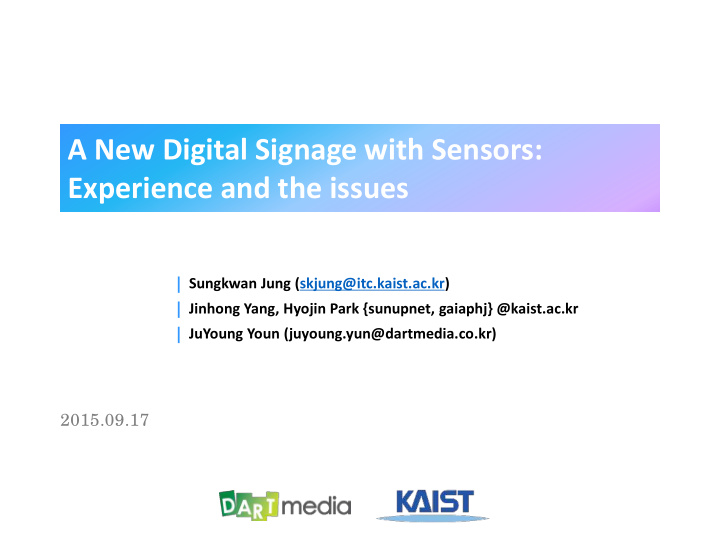



A New Digital Signage with Sensors: Experience and the issues | Sungkwan Jung (skjung@itc.kaist.ac.kr) | Jinhong Yang, Hyojin Park {sunupnet, gaiaphj} @kaist.ac.kr | JuYoung Youn (juyoung.yun@dartmedia.co.kr) 2015.09.17
Dart Media & KAIST Dart Media The first-ever ad. sales representative for VoD services, covering IPTV, Digital Cable TV and Smart TV industries. Also Wi-Fi Ads, in-app Ads and Digital Signage Ads. Digital Information Displays have been installed in 22,000 apartment buildings in Seoul and Kyunggi. 2.2Millions KAIST(Korea Advanced Institute of Science and Technology) Institute for IT Convergence Conducting the “Autonomous Smart Media Project” with Dart Media from 2014 to 2016 Researching on the new commercial service scheme for Digital Signage while operating trial services. 2
Korean Digital Signage: Service Overview Digital signage based commercial ad. market on transportations, entertainments, and outdoor advertisement has shown their growth since 2012. Major outdoor commercial service/system providers: 450000 2500 400000 350000 2000 300000 2000 250000 200000 1500 150000 100000 879 1000 50000 0 520 2011 2012 2913 400 500 교통매체 345343 389462 410207 Transportation 엔터테인매체 0 190320 219390 276650 Entertainment 2009 2010 2012 2015E 빌보드 매체 200052 206940 196044 Billboard 기타 매체 13700 29000 27640 Others [Korean outdoor commercial sales trend*] [Korean digital signage market forecast**] * Cheil worldwide(2013) ** kiwoom stocks, research center (2012) 3
Service and system requirements from the major digital signage service providers Requirements for Mapping the requirements for Web environment Digital Signage 1 Targeted commercial exposure Need to define metadata within the commercial to provide the information on their distributions Need a dynamic Tag to provide situation-aware service Measurements for the exposure to 2 effectiveness analysis Need elements(or attributes) for tracking within the commercial Interoperability on heterogeneous 3 H/W environments Linkage with mobile and customer 4 Need new Device API to communicate with the digital signage devices device (can be added on the existing Device API) Wide adaptability on the screen 5 size by content size Extended functionality to carry the Web Objects (Beacon, Content PAN TM , etc.) Be able to provide targeted information using the distribution 6 Cost-effective system build-up information within the contents’ metadata Particular content delivery for 7 emergent situations Need a Tag on the exposure to provide situation-aware service Robustness operation along with 8 legacy systems 4
Use case of the adaptive smart commercial delivery service for digital signage Situation #1 Commercial Campaign Page 6 3 2 Advertiser 6 5 4 3 Customized 2 1 Web Browser Segmented User Full-version Commercial Ad. Server Customized Situation #2 Sensor APIs Internet 5 Camera 4 Sensor Lux 1 Humidity Sensor CO2 Sensor Ad. Delivery System Temperature Sensor Sensor for Digital Signage User Digital Signage 5
Problem Statement The APIs to provide the sensor data from digital signage to the Web browsers The interfaces that enables the Web browser to access to the various sensors (camera, proximity, CO2, lux, temperature, humidity, etc.) Besides the APIs that has been dealt at the Device APIs WG, the standard interfaces that can support the content rendering on the public device environment like digital signage Description of content distribution condition for digital signage Ontology description for each content or segment which can be selectively exposed by the environmental conditions Interoperability with the legacy W3C Media Ontology to be able to interoperable with current Web [1] 6
Our Approach Metadata for Distribution Condition Name Type definition Description (attName=“minUserObjCount", attValue=“Integer"), (att - Describe the expected number of users Name=“maxUserObjCount", attValue=“Integer") - Describe the recognized number of users from th userObjCount e digital signage device (attName=“minUserObjBehavior", attValue=“Decimal"), - Describe the motion data of expected users (attName=“maxUserObjBehavior", attValue=“Decimal") userObjBehavior (attName=“minTemperature", attValue="Decimal"), - Describe the expected temperature data. (attName=“maxTemperature", attValue="Decimal"), temperature (attName=“unit” attValue=“String”) (attName=“minLux", attValue="Decimal"), (attName=“m - Describe the expected lux data. lux axLux", attValue="Decimal") (attName=“minSound", attValue="Decimal"), (attName= - Describe the expected level of sound data. soundLevel “highSound", attValue="Decimal") (attName=“minCo2", attValue="Decimal"), (attName=“hi - Describe the expected CO2 density data. co2 ghCo2", attValue="Decimal") (attName=“proximity", attValue=“String") - Describe the expected distance proximity data. proximity 7
Suggestions Device APIs for emerging Ad. Devices Device APIs need to be extended to be able to support wide range of media, from various sensors to the new execution environment like digital signage. Metadata ontology for Ad. exchanges The metadata for environmental condition description and content distribution condition are also required. Cooperation with current WGs to keep the consistency and interoperability with legacy standards and technologies is needed as well 8
Recommend
More recommend